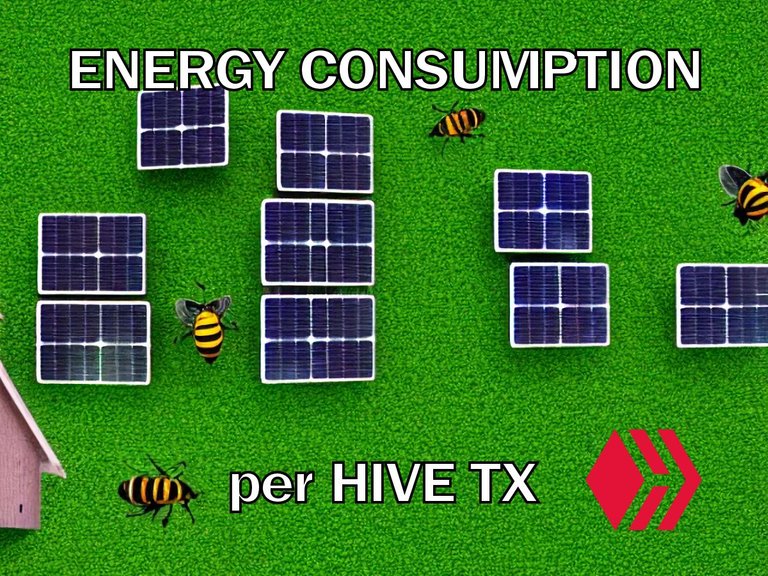Wie viel Energie benötigt eigentlich eine Hive-Blockchain-Transaktion?
Disclaimer: Die folgend Daten sind eine grobe Schätzung und stellen eine Momentaufnahme dar, da sich die Anzahl der Nodes, die Mining Power und die Anzahl der Transaktionen jederzeit ändern können.
Hive nutzt als Consensus-Algorithmus ein delegated Proof of Stake (DPOS)-Verfahren, also kein Proof of Work, und ist daher sehr energieeffizient.
Aber wie viel Watt braucht der Betrieb der Blockchain eigentlich?
Diese Frage hat mir @manncpt bei einem Hive-Meetup gestellt und mich zu diesem Post inspiriert.
Grundsätzlich muss man zwischen der Blockchain und den Front-Ends (DApps) unterscheiden.
Die Front-Ends sind im Prinzip Web-Apps, die Hive API-Server nutzen. Hier ist der Energieverbrauch in etwa mit einer großen Website vergleichbar, wobei der tatsächliche Energieverbrauch stark von der Nutzung und Anzahl der Zugriffe abhängt. Genauso wie bei Facebook oder Google.
Fokussieren wir uns im Folgenden auf die Blockchain an sich. Die Blockchain wird von den Witnesses (Block Producer) validiert und gespeichert.
Derzeit gibt es circa 100 aktive Nodes. Angenommen die Nodes brauchen im Durchschnitt 300 Watt, manche mehr, manche weniger. Dann sind das insgesamt 30kW bzw. pro Tag 720kWh.
0.000297 kWh pro Hive-Transaktion
Für das Validieren der Transaktionen (ca 2,4 Millionen pro Tag) beträgt der Verbrauch pro Transaktion dann lediglich 0.000297 kWh, circa 0.3 Watt-Stunden. Das ist fast nichts.
Zum Vergleich eine Bitcoin-Transaktion (ohne Lightning Netzwerk) schlägt umgerechnet mit circa 700 kWh zu Buche, das 2 Millionen-fache, wobei bei Proof Of Work der Energieverbrauch unabhängig von der Anzahl der Transaktionen ist.
Bitcoin könnte mit dem Lightning Netzwerk praktisch beliebig viele Transaktionen bewältigen, ohne wesentlich mehr Energie zu verbrauchen. Weiters wird der Mining-Reward alle vier Jahre halbiert. Das relativiert den Energieverbrauch von Bitcoin wieder etwas.
Wichtiger als die absoluten Zahlen, ist der Nutzen, den eine Blockchain generiert und wie die Energie produziert wird? Wie hoch ist der Anteil erneuerbarer/co2-neutraler Energie ist das Wesentliche.
Was sagt ihr dazu? Hive ist eine sehr energieeffiziente Blockchain.

AI-generated Illustration (Stable Diffusion)
English
Disclaimer: The following data is a rough estimate and represents a snapshot, as the number of nodes, mining power, and number of transactions can change at any time.
Hive uses delegated proof of stake (DPOS) as its consensus algorithm, so no proof of work, and is therefore very energy efficient.
But how many watts does it actually take to run the blockchain?
This is a question @manncpt asked me at a Hive Meetup and inspired me to write this article.
Basically, you have to distinguish between the blockchain and the front-ends (DApps).
The front-ends are basically web apps that use Hive API servers. Here, the energy consumption is roughly comparable to a large website, although the actual energy consumption depends heavily on the usage and number of accesses. The same is true for Facebook or Google.
Let's focus now on the blockchain itself. The blockchain is validated and stored by the witnesses (block producers).
Currently, there are about 100 active nodes. Let's assume that the nodes need an average of 300 watts, some more, some less. This is a total of 30kW or 720kWh per day.
0.000297 kWh per Hive Transaction
For validating the transactions (about 2.4 million per day) the consumption per transaction is only 0.000297 kWh, about 0.3 watt-hours. That is almost nothing.
In comparison, a Bitcoin transaction (without the Lightning network) consumes about 700 kWh, which is 2 million times more, however with Proof Of Work the energy consumption is independent of the number of transactions.
Bitcoin could handle virtually any number of transactions with the Lightning network without consuming significantly more energy. Furthermore, the mining reward is halved every four years. This puts Bitcoin's energy consumption back into perspective somewhat.
More important than the absolute numbers, is the benefit that a blockchain generates and how the energy is produced? How high is the share of renewable/co2-neutral energy is key.
Surprised? Hive is a very energy efficient blockchain.
Sources
[1] Blocktivity: Blockchain Transaction Stats https://blocktivity.info/
[2] Forbes: Why Does Bitcoin Use So Much Energy? https://www.forbes.com/advisor/investing/cryptocurrency/bitcoins-energy-usage-explained/
[3] Hive Blockchain https://hive.io/
Live your Secrets and Hive Prosper 🍯
xx Viki @vikisecrets


